L’Arche Montérégie
L’Arche Montérégie Art Workshop “Le Pot-en-ciel”
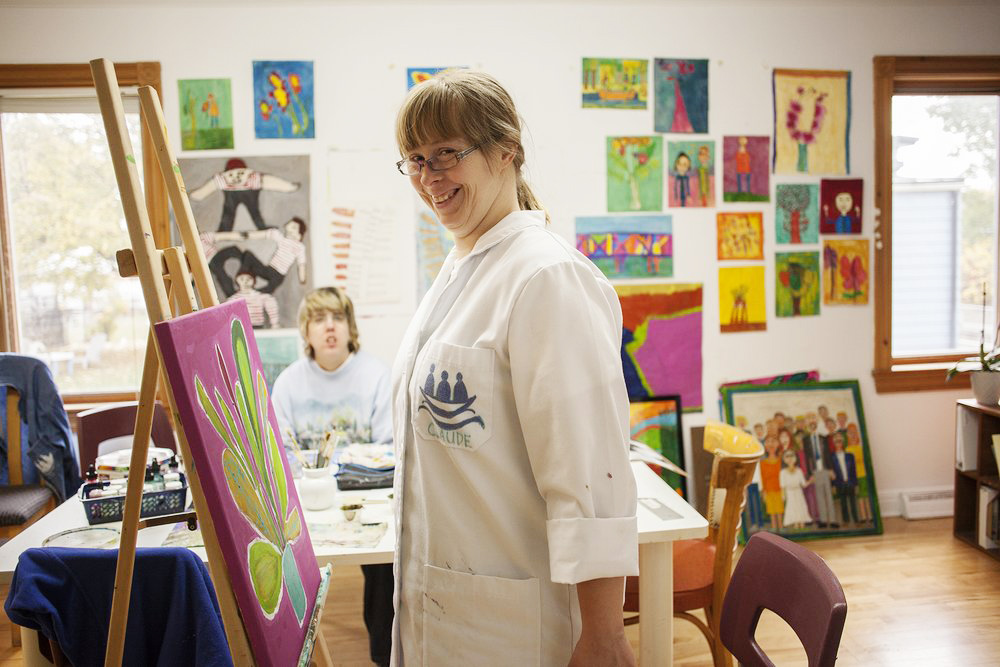
Do you have a passion for creation? Are you ready to discover an inspiring story? Visit an art workshop, specifically one where the artists are people with intellectual disabilities.
In this workshop, artists learn to view their surroundings in a new way as they take on a variety of different artistic mediums. It’s an inspiring and lively place where all artists are called to evolve, reinvent themselves and persevere and where their artwork instills wonder and contemplation.
Here we have an interview with Pot-en-ciel workshop leader Josée Lemieux. Josée founded the workshop with Claude McLean and now around twenty people with intellectual disabilities work there. This interview provides a great example on how to develop a workshop for artists with intellectual disabilities.

The late Claude McLean was a core member of the L’Arche Beloeil community and founder of the art workshop. As a tribute, we dedicate this article to Claude, who contributed to making Pot-en-ciel what it is today.
The Beginnings
Josée tells the story:
Before starting the workshop, Claude already showed artistic potential. He was always drawing and he was always the one who made birthday and Christmas cards.
One day Claude told me, “I want to make a cross for my home and I want you to help me.” Having seen Saint Damian crosses, he already had a vision but he wasn’t sure how to go about making it happen.
Since I’d been trained in art, I told Claude, “Come to my place and let’s draw together.” And that’s really how the workshop started… with Claude coming to my house to draw, at first just an afternoon… and pretty quickly it became a whole day! We had so many projects… He’d come in the morning with his lunch, we would eat together and then keep going in the afternoon.
We made so many things: cards, crosses, candles. There was quite a variety. The more Claude drew, the more I could see that he liked guidance; he was longing to learn.
As for the name “Pot-en-ciel,” (a play on the word “potential”) we were trying to think of what to call the workshop when Martyne, our secretary at the time had the Eureka moment. Everyone said, “Well, of course! That’s the perfect name for us!”
From the beginning, Claude was already saying, “One day, other people need to come work with us.”
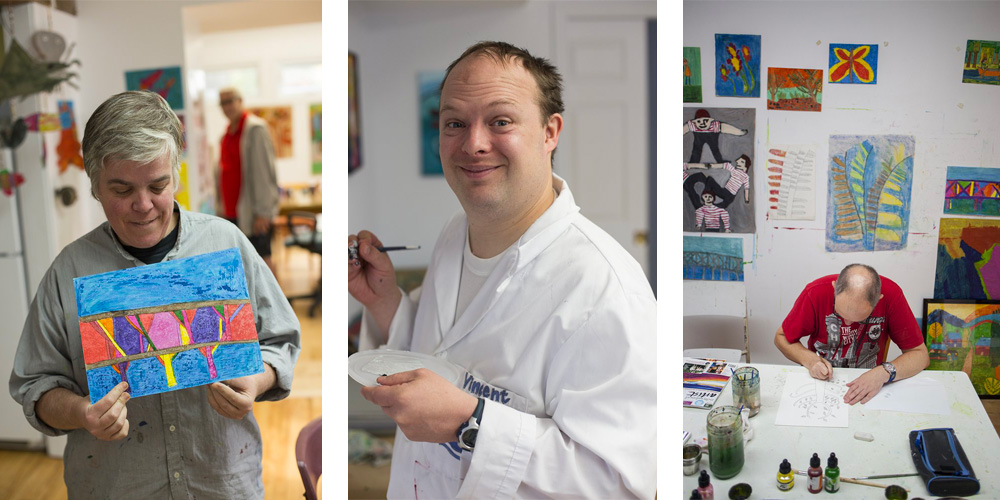
Little by little, other people from the community joined us. Claude welcomed each one of them. The workshop evolved according to the community’s needs and what the artists wanted to do.
One day Claude said, “People from outside the community need to come too.” And that’s what happened. In fact, everything that Claude said came true.
Open to Community, a Workshop whose Gifts Extend Beyond L’Arche
Over time, people from the community expressed interest. “I’d like to go to Pot-en-ciel. I want to try that too.”
We presented the project to our regional Centre de santé et de services sociaux (CSSS) [Health and Social Services Center] as a day program for adults with intellectual disabilities and obtained funding to welcome new artists. People from outside the community came and we opened the workshop for an additional day.
The endeavour’s most beautiful rewards stem from the fact that the workshop came into existence as a result of Claude’s deep desire to draw. He used to say, “I am the founder of the Pot-en-ciel workshop with Josée.”
Toward the end of his life, though he was obliged to slow down his activities, Claude insisted on continuing to spend time with the new artists. When a new person arrived, he would say, “I am going to take time to draw with her… I will show her how to make a dog.” And he would guide them through it. He’d be so happy to hear the person say, “Thank you, Claude. You taught me how to draw a dog.”
These days, the workshop’s most experienced members play an important role. They determine the pace and structure for the day. They’re the ones who set the tone for community life.
It is touching to witness the transformation of these people. They can’t get enough of the workshop and are proud to come to Pot-en-ciel.
Learning to Observe
During our first meetings, Claude would often say to me, “I don’t know how to do this or that…” We would take a look and I’d tell him that it was important to observe. “Here,” I’d say. “Let’s look out the window and see how the tree is made…”
After a while, we realized that Claude really liked to observe and this helped him create.
We’d look through magazines or art books… He’d use them to find inspiration. He had that natural curiosity to try and discover, to understand, to work and then feel good about everything… Because you have to feel good. You have to have the patience to sit and draw and wait for the transformation.
For Claude, this was natural. I believe he was a true artist. He had the capacity to sit, look, reflect and do his work, and then after he’d act as his own critic. He’d observe and say, “Oh yes, I could have done that differently… Oh this, I’ll do this to fix it, I don’t like it.” He already had this artistic side to him.
It was in 2009 that we really found our way and discovered the spirit and goal of the workshop.
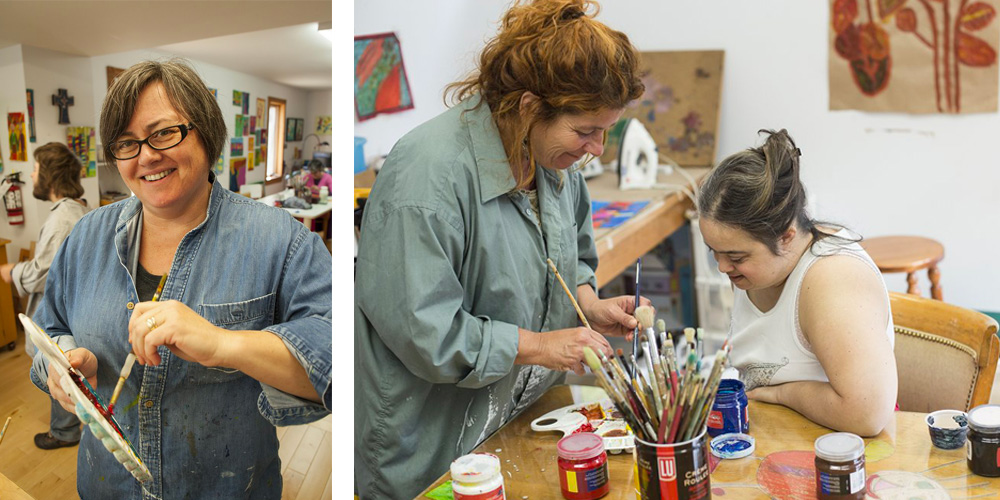
This is when I realized that people were able to take the time to enter into the creative space and observe… To engage with a form of introspection on what they were drawing, and to be able to take this further.
And for us this was truly a revelation. “Okay,” we said. This is how we’re going to accompany our artists.” We are going to encourage them to go further, to draw not just for the sake of making a drawing, but to accompany them through a real process.
Zizi
When Zizi, Élisabeth Eudes-Pascal came to the workshop, we shared our vision with her of how to accompany people in their work, hoping to be able to go further.
Zizi is trained in drawing and painting… She is an illustrator and continues to practice observational drawing.
Zizi told us that, “Today I still need to go to life drawing workshops with live models, to learn how to look, so that my drawing seems alive. To illustrate and draw well, I still need to observe.”
We saw that some people were already talented.
But even with an innate talent or gift, doing the work is still essential. We saw that some people particularly needed our accompaniment and for us to believe in their capacity to evolve.
Some people did repeat the stereotypes that they’d learned and had been praised for. “Wow! You can draw a tree, a sun, a house…” Sometimes we needed to de-construct the previously learned images to get them to observe with more depth and go further… by looking at things differently.
What is a branch made of? How is the branch attached to the tree? This is how we observe when we go outside. We rediscover our surroundings. “Look at the window. What colour is it? It’s black… with blue reflections…”
I love it when we receive flowers! Because then we can really take the time to analyze them. What is a flower made of? A sunflower… They all dream of drawing sunflowers… but when we have a real one in front of us, how is it made?
Each person is working on this concept of observation, and like all artists, everyone has a different way of seeing the same thing. Drawing isn’t just sitting in a chair and passively filling your paper; we need to teach artists to be dynamic in the creation process and to develop their own vision of the subject.
A Variety of Mediums and Approaches
We try to explore different mediums: wax crayons, coloured ink, paper, canvas, nib and India ink, pastel… We try to explore as much as possible, and help the artists feel comfortable with the medium while also encouraging them to challenge themselves.
For each piece, we begin with a pencil sketch on paper… Then we get started on the canvas using a water soluble pencil so that we can erase certain lines and make a few corrections… And afterwards, we trace with a fine tip marker or with Indian ink and a brush or nib. Once we’ve coloured with wax crayons, we switch to coloured ink.
Other artists who are comfortable with these mediums explore acrylic or collage which allows them to experiment. Charles actually did an entire series of acrylic on cardboard, paper and canvas. We try to mix things up to encourage people to develop different techniques.
Although the people in our workshop are fairly autonomous, they do need some guidance and assistance in how to proceed with each of their projects’ steps.
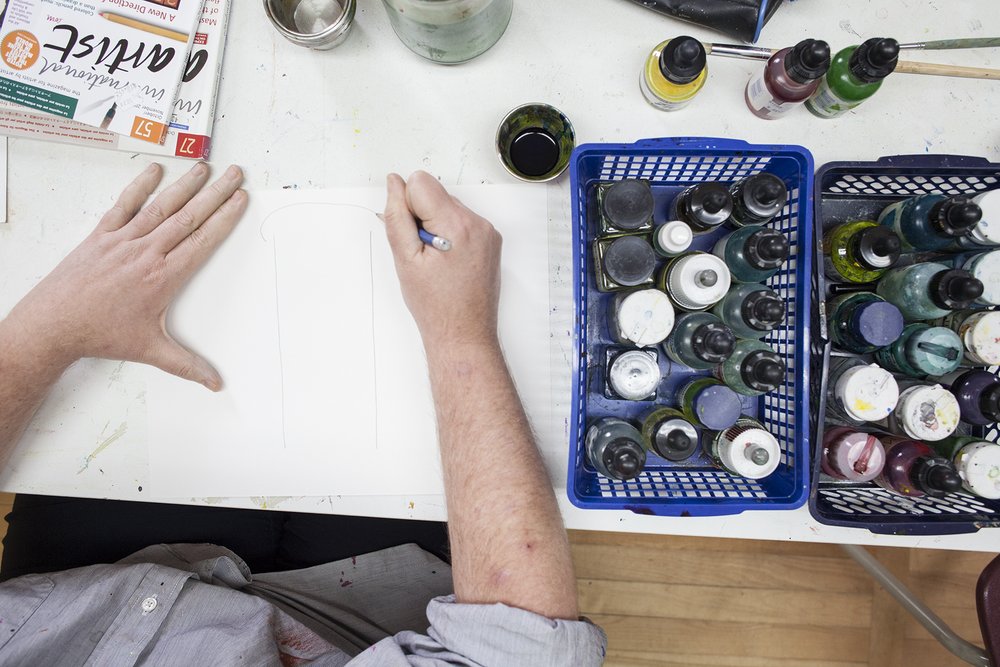
Schedule
People come regularly every week. Doors open at nine o’clock and we take time to plan our day and offer up the outcome. From there, our work begins. We work until our coffee break and then until lunch. After lunch, we work through to three o’clock. Over the course of one day, artists have time to complete a number of different steps on their projects.
People begin to recognize each artist’s personal style
Each artist has his or her own particular style. Even when using a similar medium, the results are always unique.
Over time, our artists with intellectual disabilities really discovered their own aesthetic and people surrounding the community began to notice. “Oh, I recognize this one! Lucille made it,” they say. Or, “Charles did this one, didn’t he?”
Integrating into the Workshop
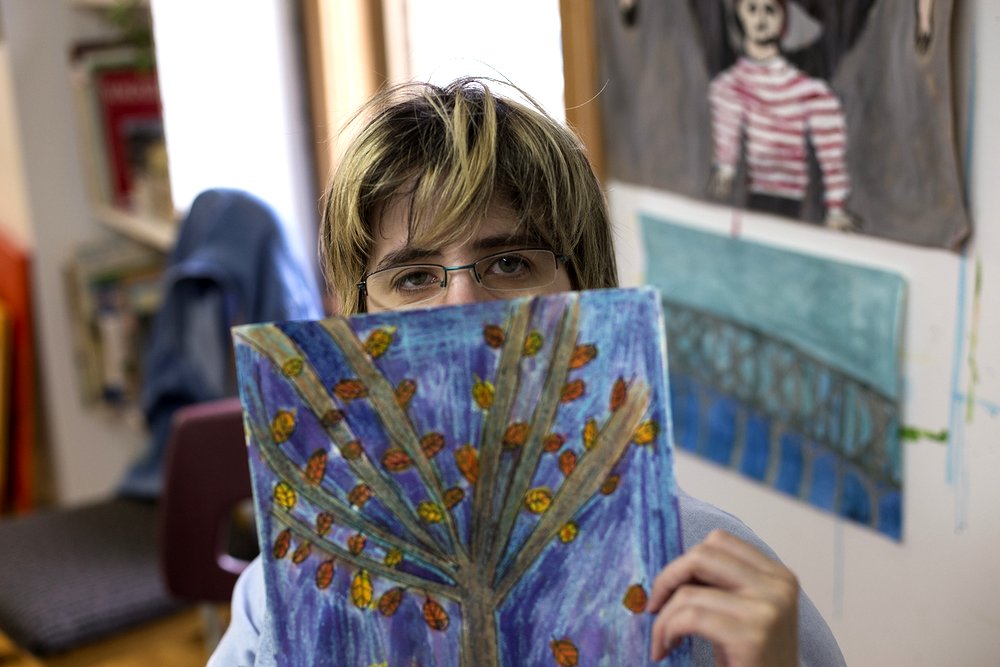
We can see rather quickly whether or not people are able to enter into this creative space. Not everyone is in a position to participate and they may not necessarily feel comfortable. This becomes pretty obvious. After one or two days in the workshop, we can tell if someone is in the right place.
The artists love displaying their work. They are so happy to share their creations. At the workshop’s vernissage, they are delighted to welcome their family and friends. The exhibition is a motivating event that inspires artists to continue their work.
They want to be there, to be part of the workshop. For our artists, it’s a transformative experience.
A Workshop Participant’s Transformation
One day, a new person arrives at the workshop. She doesn’t talk much and she seems quite closed off from those around her. But she draws quite a bit, and super quickly. I note to myself, “She has something very spontaneous happening.”
More and more, she starts to speak and share with us. Sometimes I give her a few pointers. “Slow down,” I say. “Take your time!”. And after a while, she comes to me and says, “Look! I’m going slower!”
I think it’s wonderful when people are aware of their own evolution.
Inspiration and Creativity
Just as it is for all artists, there are periods when everything flows and it comes out easy. This is lovely. Something’s happening. And other times things seem blocked. It’s all part of the process.
To Conclude
Backed by more than 20 years’ experience and research, the Pot-en-ciel workshop has developed methods that are adapted to the creative needs of artists with intellectual disabilities. We’ve accomplished this by providing these artists with a workshop that encourages their growth and artistic development. Since 2009, we have organized an annual exhibition to promote the artists’ creations throughout the regions. Hundreds of pieces have been sold. This success clearly demonstrates the value of their work and contributes to changing our society’s perception of difference, one masterpiece at a time.
Follow Pot-en-ciel’s artists on Facebook or at L’Arche Montérégie’s website where we’ll be announcing our upcoming expositions.
Information
221 Bernard-Pilon St.
Beloeil (Québec) J3G 1V2
Tel.: (450) 446-1061
Fax: (450) 446-2396
Website: www.larchemonteregie.org
Facebook: www.facebook.com/larchemonteregie
Email: info@larchemonteregie.org
Community Leader:
Marie Fréchette
-
Atlantic Region
L'Arche Antigonish L'Arche Avalon (Project) L'Arche Cape Breton L'Arche Halifax L'Arche Homefires L'Arche Saint John -
Québec
L'Arche Abitibi-Témiscamingue L'Arche Outaouais (Agapè) L'Arche Montérégie L'Arche Lanaudière L'Arche de la Capitale-Nationale (l'Étoile) L'Arche le Printemps L'Arche Mauricie L'Arche Montréal -
Ontario
L'Arche Arnprior L'Arche Daybreak L'Arche Hamilton L'Arche London L'Arche Ottawa L'Arche Stratford L'Arche Sudbury L'Arche Toronto -
Western Canada
L'Arche Calgary L'Arche Comox Valley L'Arche Edmonton L'Arche Lethbridge L'Arche Greater Vancouver L'Arche Saskatoon L'Arche Winnipeg